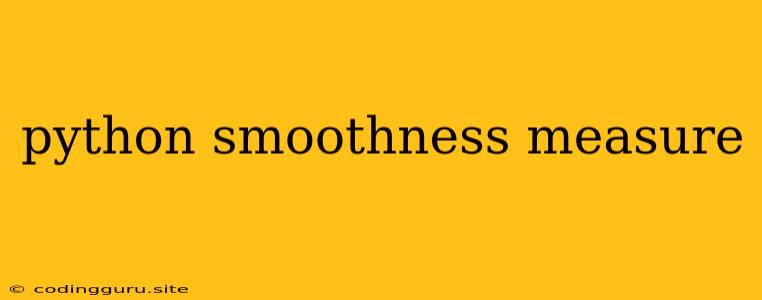Exploring Smoothness Measures in Python
Smoothness is a fundamental concept in various fields, including signal processing, image analysis, and machine learning. It essentially quantifies how "smooth" a function or data set is, indicating the absence of sudden jumps or abrupt changes. In the world of Python, there are various methods and libraries available to evaluate smoothness, each with its own strengths and applications.
What is Smoothness?
Before delving into Python implementations, let's understand the essence of smoothness. Imagine a graph depicting a function. A smooth curve would flow gracefully without any sharp turns or sudden peaks. Conversely, a rough curve would exhibit abrupt shifts and high frequency fluctuations.
Intuitively, smoothness represents the absence of high-frequency variations. It indicates a gradual and continuous change over time or space.
Why Measure Smoothness?
Understanding smoothness is crucial in various contexts:
- Signal Processing: Identifying and filtering noise from a signal, especially in applications like audio processing or medical imaging.
- Image Analysis: Analyzing the quality of images, detecting edges, and smoothing out artifacts.
- Machine Learning: Building models that capture underlying trends and patterns in data, avoiding overfitting.
- Optimization: Finding optimal solutions to problems where smoothness plays a role, like minimizing the energy of a system.
Measuring Smoothness in Python:
Here are several popular methods for evaluating smoothness in Python:
1. Using Numerical Derivatives:
One approach is to calculate the derivative of the function or data set. A smooth function would exhibit small or gradual changes in its derivative, while a rough function would have large and frequent changes.
Example:
import numpy as np
def smoothness_derivative(data):
"""
Calculates a simple smoothness measure using numerical derivatives.
Args:
data: A NumPy array containing the data.
Returns:
float: A smoothness score based on the derivative.
"""
derivative = np.diff(data)
smoothness_score = np.mean(np.abs(derivative)) # Smaller values indicate more smoothness
return smoothness_score
data = np.array([1, 2, 3, 5, 6, 7, 8, 9, 10])
smoothness = smoothness_derivative(data)
print(f"Smoothness Score: {smoothness}")
2. Employing Curve Fitting:
Another method involves fitting a smooth curve (e.g., a polynomial or spline) to the data and assessing the goodness of fit. A good fit indicates a higher degree of smoothness.
Example:
import numpy as np
from scipy.interpolate import UnivariateSpline
def smoothness_spline_fit(data, smooth_factor=10):
"""
Measures smoothness by fitting a spline to the data.
Args:
data: A NumPy array containing the data.
smooth_factor: A parameter controlling the smoothness of the fitted spline.
Returns:
float: A smoothness score based on the goodness of fit.
"""
x = np.arange(len(data))
spline = UnivariateSpline(x, data, s=smooth_factor)
smoothness_score = spline.get_residual() # Smaller values indicate better fit, hence more smoothness
return smoothness_score
data = np.array([1, 2, 3, 5, 6, 7, 8, 9, 10])
smoothness = smoothness_spline_fit(data)
print(f"Smoothness Score: {smoothness}")
3. Utilizing Libraries for Specific Applications:
Several libraries offer dedicated functions for smoothness evaluation tailored to specific domains:
- SciPy: The
scipy.signalmodule provides tools for signal processing, including functions for smoothing and filtering. - Scikit-image: For image analysis, this library provides filters and algorithms specifically designed for smoothing images and enhancing their visual quality.
- PyTorch: This deep learning framework incorporates functions for evaluating gradients and Hessians, which can be used to quantify the smoothness of neural network models.
Example (SciPy):
from scipy.signal import savgol_filter
def smoothness_savgol_filter(data, window_length=5, polyorder=3):
"""
Applies a Savitzky-Golay filter to smooth the data.
Args:
data: A NumPy array containing the data.
window_length: The size of the smoothing window.
polyorder: The order of the polynomial used in the filter.
Returns:
NumPy array: The smoothed data.
"""
smoothed_data = savgol_filter(data, window_length, polyorder)
return smoothed_data
data = np.array([1, 2, 3, 5, 6, 7, 8, 9, 10])
smoothed_data = smoothness_savgol_filter(data)
print(f"Smoothed Data: {smoothed_data}")
Conclusion
Determining smoothness in Python involves a range of techniques, from basic numerical derivatives to advanced curve fitting and specialized library functions. Choosing the right method depends on the specific application and the nature of the data being analyzed. By employing these tools effectively, you can gain insights into the underlying characteristics of data sets, signals, and images, enhancing your ability to process and analyze information effectively.
